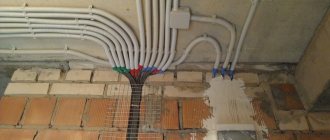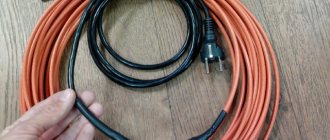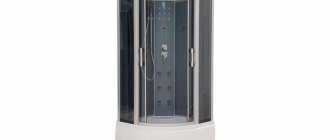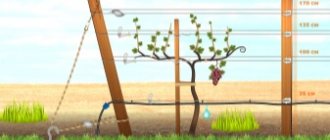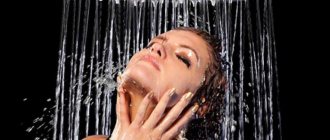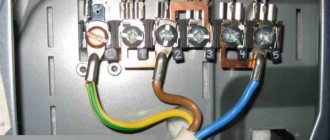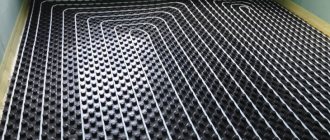Laying out water supply pipes is a problem that has to be solved during a major overhaul. Sooner or later, the time comes when the water supply system becomes unusable. There can be many reasons for repairing and replacing the water supply system; we will list the main ones - the formation of fistulas, condensation on pipes, the appearance of rusty water from the tap, etc.
Is it possible to replace the water supply system in an apartment or private house on your own? After all, the work of plumbers will not be cheap. And the answer to this question is positive - yes, this is possible.
At the same time, special permits and registrations will not be required for work. All that is necessary is to shut off the water supply to the riser for an hour.
All work on installing the water supply system will have to be carried out in strict sequence, otherwise the constructed structure will not operate without failure.
The types of pipe layouts affect the quality of water supply to water supply and heating systems, as well as the durability of communications and their maintainability. Tee and manifold wiring diagrams are used.
The need for competent pipeline design
Assembling the water supply pipeline by a master.
A standard water supply project for an apartment involves wiring from a common hose to sinks installed in the bathroom and kitchen. But the development of household appliances places increased demands on documentation.
For example, for a washing machine or dishwasher it is necessary to install additional outlets with safety valves.
The equipment is demanding in terms of water pressure, which decreases if the lines are laid incorrectly.
Bathroom
The pipes in the bathroom are changed using a similar method. Usually the bathroom is adjacent to the toilet. And the pipes come here through the wall. We arrange them in parallel. We connect in several places. This is a measure against sagging. Where it is planned to place plumbing fixtures and a washing machine, we arrange branches. We install ball valves at their ends.
You need to place a faucet above the bathtub. To do this, we tap the walls, because sections of the pipes should be deepened. At their ends we place a special bar with flanges fixed at a certain distance. They are fixed discreetly to the wall surface. It is necessary to take into account the density of the cladding material.
Basic methods for laying pipes in a residential area
Before installing water in an apartment, you must choose one of the following methods:
- sequential (in a number of sources referred to as tee);
- collector;
- combined (includes sections with sequential and collector circuits).
Serial connection diagram
Tee pipe distribution consists of a central common line to which consumers are connected in series. For example, hot and cold supply systems in apartment buildings are assembled according to this scheme.
The main collector pipeline has an increased diameter to supply additional volume of liquid to consumers. The name “tee” is used because of the installation of tees on the main line, allowing the connection of additional plumbing equipment.
The method is characterized by ease of design and implementation. The fewer highways that need to be installed in a room, the lower the cost of the structure. The technology is not used with a large number of consumers, since there is a gradual drop in pressure.
In case of repair of water pipes, it is necessary to completely shut off the liquid supply (the distribution valve is located near the cold water and hot water riser).
The disadvantage is difficult access to pipelines and connectors hidden under decorative trim (if hatches are not provided in advance).
Tee connection wiring.
Manifold pipe routing
Radial or collector distribution of water supply pipes in an apartment is designed for rooms with a larger area and a large number of water distribution points.
The circuit includes a collector (connected to the riser), from which a separate branch (both cold and hot supply) is laid to each consumer.
The technology provides uniform pressure, regardless of the number of devices turned on and the length of pipelines. In the event of a breakdown, only the section with the faulty point is switched off.
The radial circuit ensures the installation of filters and reducers for each device, allowing you to regulate the water pressure in accordance with the requirements.
The disadvantage is the increased number of hoses or additional components, which increases the complexity of assembly and the cost.
In the apartment, it is necessary to provide space for collectors, in front of which a main shut-off valve is installed (in new buildings, automatic valves with a leakage sensor are often used).
Manifold pipe installation.
Combined scheme
The combined technology is used in rooms with a branched layout (for example, in multi-room apartments or hotels). A manifold for water supply to consumers is connected to the riser; branches with tees lead from the device to supply liquid to a group of rooms.
The wiring diagram allows you to connect a large number of water points to the riser. In case of damage, some consumers have to be disconnected. The technology allows you to reduce the cost of purchasing additional materials and installation work in the apartment.
Life time
- How long do water supply and sewerage pipes last (see Service life of metal pipes)?
The service life of equipment is prescribed in departmental building codes VSN 58-88 and is:
- For black steel pipes - 15 years;
- For galvanized steel pipes - 30 years;
- Cast iron sewerage has a lifespan of 40 years;
- Plastic sewerage has a 60-year lifespan.
Departmental standards contain the service life of finishing, materials and equipment
However: SP 30.13330.2012 prescribes the use of materials for water distribution with a service life of at least 50 years for cold water and 25 years for hot water. This instruction is relevant for all buildings under construction and for old buildings undergoing major renovation.
Features of collector installation
The device is a metal or plastic hollow body with a hole for connecting to the riser and several outlets for connecting pipelines.
The inlet cross-section is 25-30% larger than the size of the outlet channels, which supports the supply of liquid to several consumers with a constant pressure.
Metal collectors have threaded couplings for installation. Plastic adapters for polypropylene are equipped with compression-type fittings or solder adapters.
There are designs with conical bushings, which allow the installation of hoses made of metal or plastic and simplify the operation of the water supply system.
When selecting a distributor circuit, take into account the flow temperature (there are models for hot or cold pipelines) and the number of outlets (the standard provides from 2 to 6 outlets).
If a larger number of consumers are used in the room, then several products will need to be connected in a series circuit. Each dispensing unit is equipped with a separate pipeline with a threaded plug.
Installed collector.
Nuances for different types of bathrooms
In apartment buildings there are several types of bathrooms:
- separate, in which there is a concrete wall between the bathroom and the toilet;
- combined, without internal partitions (some owners dismantle them, further increasing the area of the room).
Combined
In such a bathroom, the water supply lines are routed along the wall along the perimeter of the room from the riser through cut channels. Couplings are provided at consumer connection points.
Ball valves are placed in a shield or covered with a box. After laying the mains, the channels in the wall are sealed with a cement mixture, and finishing material (for example, tiles) is installed on top.
Perimeter wiring in a combined bathroom.
Separated
When wiring in a separate bathroom, a hole is cut in the wall necessary for supplying a sewer drain or water supply to the riser.
The lines for supplying liquid to consumers are located inside the walls.
If necessary, provide an additional connection point for a washing machine, heating radiator or heated towel rail (the coil on the wall is heated by circulating hot water).
Wiring in a separate bathroom.
Selection of pipes for the water supply system
Several types of products differing in material are used to supply water:
- Copper pipelines connected by soldering are characterized by increased elasticity and corrosion resistance. Designed for operation at temperatures up to +250°C. Equipment is required for bending or soldering workpieces. When installing metal bushings, a galvanic couple is formed, which leads to the destruction of parts. Products of this type are rarely used in apartment buildings due to their high price and electrical conductivity.
- Steel with surface galvanization was used in the USSR in the construction of buildings. They are connected by resistance welding or threaded couplings. They are not highly resistant to corrosion; hidden mounting in apartment walls is not allowed.
- Metal-plastic products with increased elasticity. They are connected by threaded bushings or by crimping. The blanks are not suitable for hidden installation in apartment walls; they are corrosion resistant. The inside is not covered with deposits.
- Polybutylene type, withstands heating up to +90°C. The workpieces are connected by soldering. Due to the high price, they are used to a limited extent (for example, when installing heated floor coverings).
- Reinforced polyethylene blanks can withstand pressure up to 3.5 atm. Increased elasticity allows water to solidify, so the products can be used in summer cottages. It is not recommended to install it within the walls of residential buildings.
- PVC products, joined by glue or soldering, are used for process water pipes. They can withstand pressure when supplied with liquid no higher than 3.5 atm, and degrade under the influence of ultraviolet radiation.
- Polyisopropylene type. The blanks are designed for pressure up to 12 atm. and temperatures up to +130°C. They are distinguished by their low price and are resistant to the formation of salt deposits. They are used for the construction of risers and wiring in residential buildings and office premises.
Water pipes.
Dismantling stage
The first step is to turn off the water at the risers with water (both hot - hot water and cold - cold water). If you need to replace the riser pipes, you will have to go down to the basement to turn off the water. Here are the following features:
- Mandatory coordination of work with the company working with communication systems inside the house.
- It is necessary to inform the neighboring residents along the riser in advance about the planned work and shutting off the water.
- Ensuring that pipes are replaced and the water supply is restored.
I recommend connecting new products to the network in neighboring apartments above and below.
When these nuances are settled, you can cut the old pipes. But before that, be sure to drain the water from the risers. We retreat 50 cm from the floor and ceiling in relation to adjacent apartments. The cut is perpendicular. This will make it more convenient to create carvings.
We loosen the piece of pipe concentrated in the slab with a hammer. Then we simply knock out this segment. We also remove the fasteners of old pipes.
Which is better: closed or open pipeline
When choosing a method of installing a water supply system (open or hidden), the design of the room, the number of consumers and the material of the pipelines are taken into account.
If steel or metal-plastic products are used, then placement inside the walls is not allowed. Products made of polypropylene are suitable for hidden installation, but it is necessary to make high-quality joints. If a leak occurs during operation of the water supply system, it will be necessary to remove the finishing from the walls, which leads to repeated repairs of the room.
When embedding into concrete walls, it is necessary to take into account the characteristics of the material, which should not expand when heated, or an expansion gap should be provided.
When laying, corrugated plumbing hoses are used. Additional shells compensate for temperature deformations or protect the floor or walls from the effects of condensation that appears on the surface of pipes for cold liquid.
The closed shape of the pipeline looks more aesthetically pleasing.
Preparatory stage
Here I recommend making a list of the necessary communications and plumbing fixtures. For example, a toilet and washing machine must be connected to a cold water supply (CWS) and sewerage. A washbasin and bath (or shower) require additional hot water.
Here, too, the owners must resolve the issue of the number of shut-off taps. They are mounted on the inlet to the washing machine. You can put them on the supply to the toilet.
Next, issues with tools and materials for replacing pipes are resolved.
The list of tools is as follows:
- Bulgarian. It requires a metal disc.
- Manual clamp. Its diameter must match the parameters of the riser.
- Hammer.
- Soldering iron + attachments for it. Pipe cutter They make work in the kitchen and bathroom easier.
- Hammer.
- Screwdriver Set.
- Tape measure and marker.
- Chisel.
Materials:
- Two adapters of a certain diameter for moving from one pipe to another (from metal to plastic).
- Polypropylene pipes. Purchased in required quantity. Their parameter is half an inch. I recommend the Pro Aqua brand, reinforced versions. Price per meter: 43-77 rub.
- Tees.
- Distributors and other fittings.
- Self-tapping screws, fasteners,
- Fum tape. I recommend Ftoroplast. Price tag – 750 rub.
Other elements are also needed. Their exact number is determined after the formation of the water supply installation scheme.
Have questions ? Call!
What is needed for work, except pipes
When arranging a water supply system, not only the location and material of the lines are taken into account, but also additional equipment is used to ensure the safe operation of the plumbing equipment.
The devices are located in a separate distribution box equipped with a removable or hinged door. The volume of the cabinet provides the owner with unhindered access to components for maintenance or repair.
Shut-off valves
The main ball-type valve, located next to the riser, separates internal networks from external ones and allows you to turn off the water in the apartment during repairs.
The unit operates in 2 extreme positions; intermediate positions are not required. Since the water supply ball valve experiences increased loads and must ensure a hermetically sealed channel, the home owner is recommended to purchase products from Valtec or Bugatti.
Shut-off valves for water supply pipes.
Emergency equipment
Emergency shut-off devices allow you to shut off the liquid supply in case of leaks without owner intervention. A standard mechanical blocker is designed for a certain volume of fluid flow.
If the parameter is exceeded, the product blocks the channel (for example, similar devices are used in washing machines). Electromechanical units are connected to a household AC network and equipped with sensors that detect the presence of liquid on the floor. After the sensor is triggered, the motor is turned on, turning the ball axle box of the crane.
Assistive devices
Additional devices are installed in the distribution cabinet:
- Pointer or digital pressure gauges that allow you to determine the pressure and record peak values. The products are placed at the inlet and after the regulator or after the filter block (to determine the pressure drop coefficient, which indirectly indicates the condition of the cartridges). Pressure gauges are mounted on separate tees. There are schemes with devices integrated into the filter or with pre-mounted threaded fittings.
- Distribution blocks required when constructing a collector water supply system. The housings are equipped with fittings for connecting to the riser and fastening the outlet lines. When installing the comb, it is necessary to consider the location of the outlet pipes with ball-type valves. The distributor housing has fittings for attaching additional equipment (for example, circuit breakers or pressure sensors).
Filters for water purification
The water supplied to the premises contains foreign mechanical impurities that damage plumbing equipment. A coarse filter with a metal mesh separates particles up to 100 microns in size.
Collected garbage is periodically removed manually. To clean the filter, you need to close the ball valve of the water supply, and then unscrew the lower part of the housing. There are water filters with a drainage channel to drain contaminants into the sewer.
For further cleaning, filters with a filler made of nylon or polypropylene fiber, capable of trapping particles with a size of 5 microns or more, are used.
As the filter becomes dirty, the throughput deteriorates; the owner must replace the cartridge (the service life depends on the quality of the water).
Complex cleaning systems use special blocks with permanent magnets, which make it possible to transfer impurities into a suspended state with subsequent capture by synthetic filter media.
Installation of cleaning filters.
Related material: The best flow-through water purification filters for installation under the sink
Regulators
The pressure regulator allows you to reduce the pressure in the water supply lines to the required value (for example, for plumbing to operate, a pressure of 3-4 atm is required).
The device reduces the risk of hot liquid mixing and protects equipment from water hammer. Some owners install additional load absorbers with a piston or membrane module.
The control units contain mechanical valves that prevent backflow (for example, dehydration of an electric boiler leads to equipment damage).
Water consumption meters
The installation location and type of water meters are determined taking into account the requirements of the management company. The equipment should be located at the entrance to the room in a cabinet that provides readings and servicing of the devices.
Products can be installed horizontally or vertically. There are combined type meters. During installation, the permissible water temperature is taken into account.
The installation kit for the meter is equipped with a dirt filter and a check valve that prevents the flow from spinning the rotor back.
In houses, meters with a mechanical principle of operation are used. The information is recorded by the owner. There are models with an electronic unit that automatically transmits data to the service organization.
The rules for installing seals or locating metering devices are established by the sales company.
For example, some organizations do not provide for the use of seals, others do not allow meters to be mounted next to ball valves or filters with flushing fittings. It is necessary to clarify in advance the requirements, which indicate how to properly install metering devices.
Water meters.
Water supply installation instructions
Before starting the procedure, you should decide on the installation method and type of pipes used, and then purchase materials. To calculate the need, use a diagram.
It is recommended to make a margin of 5-7% in case of connection errors. If the owner of a house or apartment is not confident in his own abilities, then it is recommended to invite a specialist for consultations or to perform part of the work, since errors in assembling the water supply can lead to flooding of the premises.
What is a point in plumbing
This concept refers to the supply line for switching plumbing equipment. The device may include a hose for supplying only cold water (for example, for installing a washing machine or dishwasher) or a double hose for supplying liquid with a high temperature (for example, when installing a mixer).
Features of drawing up a wiring diagram
When developing a wiring diagram, take into account:
- places where risers enter the room and pressure;
- availability of space for a distribution cabinet with ball valves, filters or additional devices;
- location zones, number of mixers and additional consumers;
- layout and number of sewer drains;
- type of material and purpose of the walls (in load-bearing structures, cutting channels for hidden installation is not allowed).
The developed project indicates the type and marking of plumbing fixtures with a listing of consumption standards. The documentation must contain information about the hose material, flow section, length and bend angles.
It is necessary to indicate the direction of flow, the total flow, list filters, shut-off or control devices, and also indicate the number and location of the system’s protective units.
Wiring diagram.
Hydraulic calculations
When performing the calculation, take into account the standards for water consumption by plumbing fixtures, which are given in the appendix to SNiP 2.04.01-85. Then the probability and list of simultaneously operating devices are determined.
Based on the obtained value, the cross-section of the water pipe is selected from tables or calculated (with a margin of 10-15%). The calculations take into account the number of corner joints, ball valves and restrictions that negatively affect the performance of the pipeline (coefficients are given in SNiP 2.04.01-85).
Preparing tools
The list of tools depends on the type of installation and pipe material. For example, to connect products made of cross-linked polyethylene, a set of manual equipment for crimping the ends is required.
When installing polypropylene pipes, an electric soldering station is used.
If the house has steel lines, then you will need a grinder for cutting and an inverter for welding metal elements (for example, transition couplings between pipelines made of dissimilar materials).
The standard set of installer equipment includes:
- measuring tool;
- perforator;
- construction level
Precautionary measures
Safety requirements:
- installation of risers is carried out from the bottom up;
- when installing highways under the ceiling, it is necessary to use scaffolding;
- for heating plastic lines, it is allowed to supply liquid heated to +40°C;
- Before turning on the water supply, it is necessary to blow with compressed air to determine the location of leaks.
Electrical equipment is used for connection. Switching wires must not have insulation damage. The socket is used with an automatic fuse designed for the power of the devices.
Making homemade jumpers from wire or metal plates is not allowed. Welding work must be performed using protective clothing and a mask. When cutting workpieces with an angle grinder, the disc should be covered with a standard screen.
Safety precautions when installing water pipes.
How is installation done?
Installation of water supply systems is carried out from a riser or branch pipe of a pumping station (used in private houses). A ball valve is installed at the inlet section; the distribution pipes should not have a diameter of less than 1″ (otherwise the pressure decreases or the operating conditions of the equipment worsen).
If it is planned to install highways in an open way, then the pipes are mounted at a height of up to 200 mm from the floor and then covered with a plastic sleeve. Protective casing bushings are inserted into the holes in the walls to prevent damage to the water supply.
Sequence of actions when installing polypropylene products:
- Cut the workpieces in quantities corresponding to the wiring diagram using scissors or a pipe cutter.
- Calibrate the ends of the products, then remove the flash.
- Degrease the workpiece surfaces with acetone.
- Apply markings corresponding to the soldering depth (depending on the diameter of the pipeline or the dimensions of the adapters or connecting sleeves).
- Install nozzles on the soldering iron that correspond to the size of the workpieces, then set the required temperature and turn on the equipment.
- Wait until the soldering station warms up to the required temperature.
- Put on gloves, then install the workpieces into the heated adapter with a straight-line movement (rotation or rocking is not allowed) for 5-6 seconds.
- Remove the workpieces from the mandrel and align them with each other. Scrolling or rocking is not allowed, since mixing of the plastic layers worsens, resulting in the formation of voids in the material. After mating the workpiece, it is necessary to hold it motionless for 6-8 seconds until the plastic polymerizes.
- Sequentially assemble a section of the main line with ball valves or filters, which is then placed in a niche in the wall surface and connected to the riser.
- Check the tightness of the system and filters using compressed air or test operation of the water supply system, and then proceed to sealing the channels with cement or other material.
When using metal-plastic, blanks are cut and then the ends are processed with a calibration device. After installation, the nuts and rings are tightened with keys, creating a sealed joint.
The connection to the threaded part may allow liquid to pass through. During operation of the water supply system, it is necessary to periodically tighten the nuts. For installation of polyethylene products, crimping pliers are used. The resulting permanent connection is characterized by increased tightness.
Installation of plastic pipes.
Is it possible to make a water supply project online?
The owner of an apartment or cottage can develop a wiring plan on a computer (for example, using Project StudioCS Water supply for the AutoCAD program).
When calculating, it is necessary to indicate the entry points of the water supply system of an apartment building or the main water supply system, as well as the number of consumer connection points.
If the owner does not have design skills, then it is recommended to order the development of documentation from a specialized company, which reduces the risk of building an inoperable water supply system.
Five advantages of our offer
- Plumbing work is carried out using components from Rehau, Uponor, FAR, Kalde, Pro Aqua, which have the best reviews from experts and ordinary users.
- Experienced craftsmen competently select the optimal wiring method, creating diagrams of the future system taking into account the customer’s wishes.
- Established relationships with suppliers of pipe assortments and components allow you to save the customer’s money without losing quality.
- We provide guarantees for the work done, and our work is insured - thereby we relieve the customer of liability to third parties.
- The offered price is 10-15% lower than the prices of other companies.
Common mistakes in installing a water supply system
Errors when designing and assembling systems:
- Lack of thermal insulation on hot water supply hoses laid in concrete screed or inside walls. With such a wiring arrangement, part of the heat is dissipated to warm up the surrounding building material (the defect manifests itself when metal blanks are used).
- Foreign objects entering pipelines during work. When wiring, you should close the riser and ends with special plugs and additionally check the lines before joining.
- Soldering joints covered with dirt or condensation leads to the formation of pores or a decrease in the strength of the connection. When liquid is supplied under pressure, a leak appears (in some cases the joint ruptures).
- Passing pipelines through a single hole in the ceilings, which disrupts the normal operation of the water supply system.
- Incorrectly drawn up plan for plumbing in the apartment. For example, an insufficient number of shut-off valves will not allow the equipment to be repaired without completely shutting off the water at the entrance to the apartment. Each water intake point must be equipped with a separate ball valve for cold and hot water.
- Incorrect installation of water supply or sewer lines, making it difficult to maintain mains or replace components during repairs.
- Installation of shut-off valves on risers in apartment buildings. A similar arrangement of ball valves is often found in publicly available diagrams. Please note that such installation of a ball valve is strictly prohibited. If the device is discovered, sales company employees impose a fine on the owner.
How to make a diagram correctly
With properly configured wiring, water is distributed between the tap, shower, toilet cistern, bidet, washing machine, etc. In this case, each device receives a sufficient amount of liquid. The water distribution must be shown on the drawing. It also indicates the types of connections, installation methods, installation features, etc.
Before drawing up a wiring diagram, you need to decide on the materials from which the pipes will consist:
- Plastic;
- Metal-plastic;
- Copper;
- Steel.
When independently developing an apartment water supply scheme, you have to build on generally accepted norms and rules. It's better when specialists get down to business. In this case, in addition to graphical display, the document contains important information:
- list, labeling and quantity of all household plumbing products;
- information about pipe materials, diameter, length;
- the intended purpose of the pipeline and the direction of flow;
- list of necessary shut-off and control devices;
- location of protective and measuring instruments.
But this does not mean that the quality and information content of an apartment water supply diagram developed with your own hands will be lower. It all depends on attentiveness and accuracy.
What do plumbers call a point?
Plumbers use the term "point" when referring to the inlet or outlet of a plumbing fixture. When drawing up an estimate, it should specifically describe how much money it will cost to connect each point.
You need to understand that connecting a shower with hydromassage or Jacuzzi is much more difficult than connecting a regular sink or toilet. The “point” can be double if for its operation it is necessary to supply cold and hot water.
Workers are responsible for laying pipes, connecting and starting the system. Landscaping is not included in the standard range of services. The price of laying a pipeline also depends on the complexity of the work.
Useful video on the topic
The presented videos and a series of photos demonstrate methods for installing water supply in apartments or individual residential buildings.
Installation work.
The owner can use the video as a teaching aid to learn the intricacies of building a water supply system with his own hands.
It should be borne in mind that if the installation locations of collectors, taps and other devices are incorrectly chosen or if soldering is of poor quality, the joints may be destroyed, leading to flooding of several apartments and additional repair costs.
